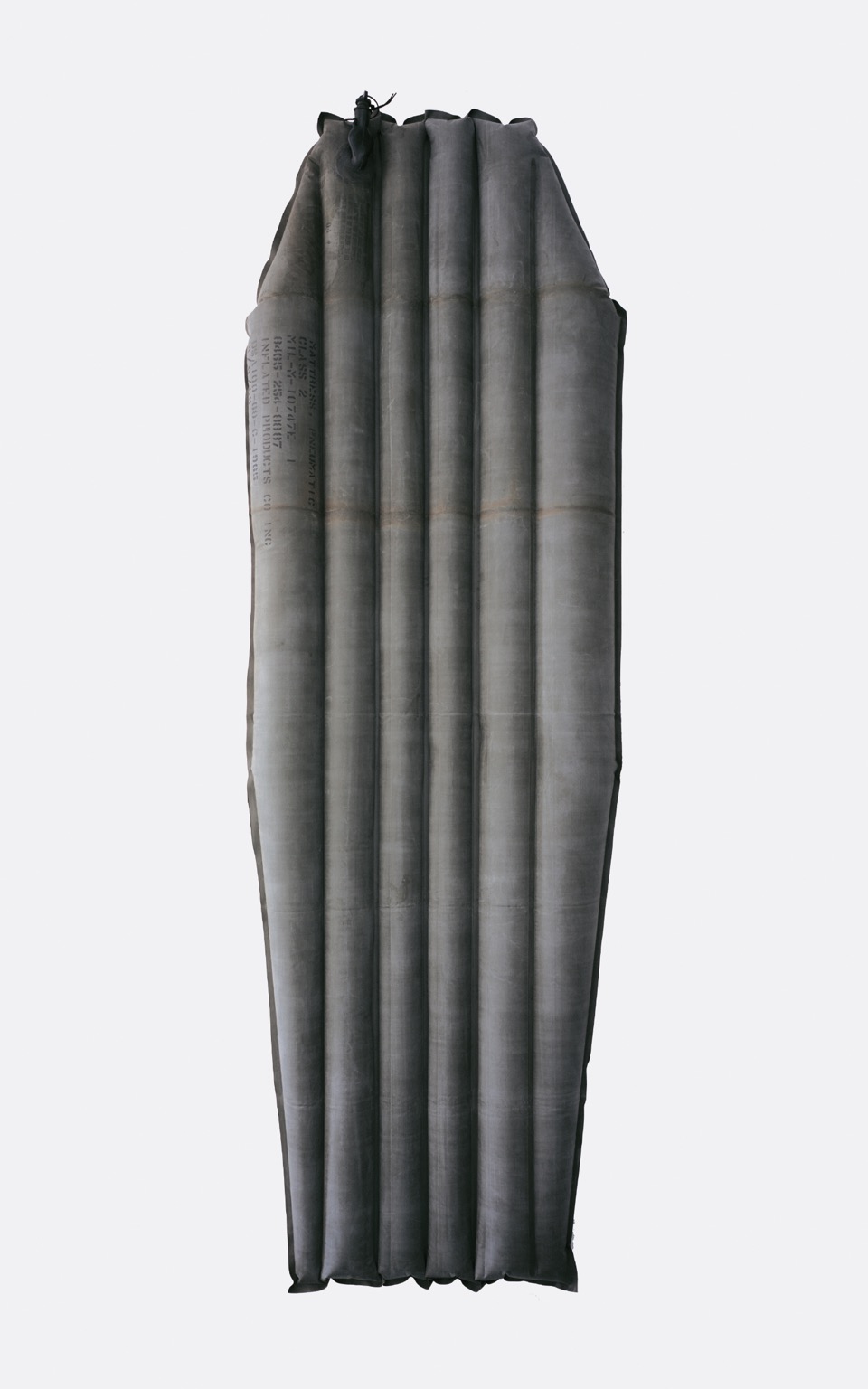On the photographic oevre of Walter Vorjohann
by Ute Thon
A military air mattress, lead-gray and more than man-sized, a valve at the head, six tubular air chambers, almost like the back of a down jacket, wear and tear on the ribbed surface, rubber seams faded into reddish-brown, the faint imprint MIL-M-10747K INFLATED PRODUCTS CO INC in the left upper corner. All of the above can be discerned accurately on the two-meter-high photograph by Walter Vorjohann. And one cannot help but wonder: Why? Why exactly this thing? Why this large? Why so matter-of-fact? Why with no comment?

The Frankfurt-based photographer Walter Vorjohann uses his camera to dissect profane everyday objects by detaching them from their contexts and staging them in large formats with extreme depth of field against a white background as if they were anatomical preparations. Electric cables, nylon tights, excavator shovels. Both the frontal perspective and the neutral background lend these objects something sublime. They become sculptures whose physical presence is reflected in the highly detailed surface structure as well as in the clearly visible signs of wear and tear. Despite such clinical presentation, the objects continue to be impenetrable and mysterious – not in the least for lack of explanatory titles. Vorjohann’s objects stand for themselves. It is only through their purely physical charisma - the tangible aura inscribed in them through their usage and function – that these objects can be approached.
As soon as one has captured these vibes, the artist provides further clues for interpretation. The air mattress photograph, for instance, is entitled “USA 1965”. From this title and the imprinted characters on the mattress, it can be inferred that we are dealing with a product from the US, the year referring to its time of use, the joyless grey color ultimately revealing its place of use. Not meant for splashing at the pool, this air mattress used to form part of the standard equipment of the US soldiers who fought in the Vietnam War. People slept, sweated, trembled and died on it – and turned the snappy slogan of Pneumatic Mattress & Cushion Company, America’s inventors of the air mattress, NOTHING SO RARE AS RESTING ON AIR, into its opposite. The air mattress, an epitome of lightness and fun, all of a sudden becomes the symbol of a murderous war, and the airy bed turns into a bier.
Walter Vorjohann is open for such interpretations, without imposing them on the beholder. Hence, you may regard his pictures of bollards (»Poller«) as photographs of concrete barriers from highways or downtown pedestrian areas, as a typology of institutional shut-off devices, or simply admire their brutalist beauty. It is also possible, however, to read this series of photographs as a frosty commentary on the precarious state of our Western democracy and its attempt to protect itself from Islamist terror by erecting concrete barriers. It is a sign of these pictures’ quality that they bear such multiple layers of meaning without showing off. Vorjohann, who has also made himself a name as an architectural photographer, sees his pictures first and foremost as photographic sculptures – temporary arrangements designed to focus on the architectonic and sculptural qualities of the represented things. In this respect, Vorjohann’s approach reminds us of Karl Blossfeldt (1865-1932), who made strict matter-of-fact black-and-white photographs of plants in the 1920s in order to document their abstract-ornamental repertoire of forms. Although Blossfeldt did not consider his photographs as original artwork but rather as teaching material for future sculptors, his plant series are regarded as classics of the new matter-of-fact photography, and his book »Archetypes of Art« (1928) is an important theoretical work.
Likewise, Walter Vorjohann also makes archetypes visible in his photographs - not from nature, but rather from industrial production. Just as Blossfeldt, he isolates objects from their natural environments, thereby making the viewer aware of their formal particularities and structural variety. As well as of the hidden layers of meaning lying dormant even in the most banal among them. For instance in a lead-grey air mattress.
Ute Thon is an art critic and managing editor of the magazine ART
(translation Eva Schestag)